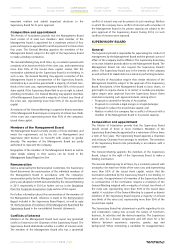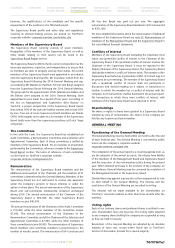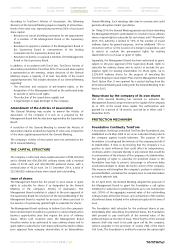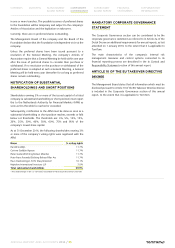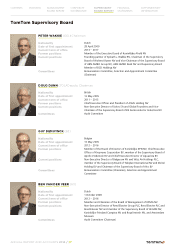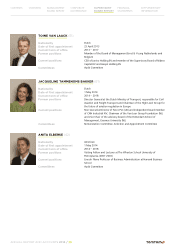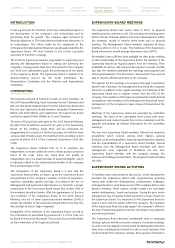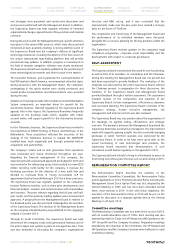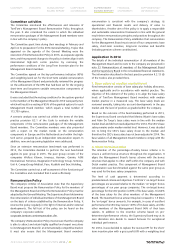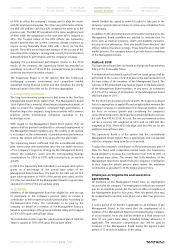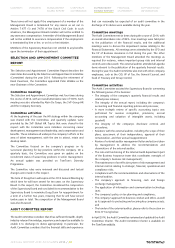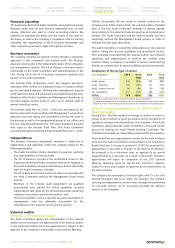TomTom 2014 Annual Report Download - page 41
Download and view the complete annual report
Please find page 41 of the 2014 TomTom annual report below. You can navigate through the pages in the report by either clicking on the pages listed below, or by using the keyword search tool below to find specific information within the annual report.
Committee activities
The Committee monitored the effectiveness and relevance of
TomTom's Management Board Remuneration Policy throughout
the year. It also considered the extent to which the individual
remuneration packages of the Management Board members were
in line with the company's policy.
The Committee spent time during their meetings in February and
April on its preparation for the 2014 General Meeting. Topics that
appeared on the agenda of the General Meeting were the
execution of the Remuneration Policy in 2013, as a separate agenda
item, and the proposed changes to the policy to better align it with
international high-tech sector practice by removing the
performance conditions of the Long-Term Incentive plan for the
Management Board members.
The Committee agreed on the key performance indicators (KPIs)
and weighting levels set for the short-term variable remuneration
of the Management Board and periodically reviewed the progress
on the achievement of the KPIs that had been set for the ongoing
short-term and long-term variable remuneration components of
the Management Board.
It was concluded that the vesting conditions for the options granted
to the members of the Management Board in 2012 were partly met,
which will result in a vesting of 65% of the granted options for each
Management Board member, which equals a total number of
113,750 options.
A scenario analysis was carried out within the terms of the best
practice provision II.2.1 of the Code to evaluate the variable
components of the remuneration packages of the Management
Board members. The Committee members were also presented
with a report on the market trends on the remuneration
components in Europe and the Netherlands and within the high-
tech sector, prepared by an independent remuneration expert. In
addition, new and upcoming legislation were addressed.
Since an extensive remuneration benchmark was performed in
2013, the Committee decided to perform the next benchmark
against its peer group in 2015. The peer group consists of the
companies Wolters Kluwer, Invensys, Harman, Garmin, ASM
International, Temenos, Imagination Technology Group, SimCorp,
Unit 4, CompuGroup Medical, Pace, Kudelski and Exact Holding.
The Committee carried out a self-assessment of the functioning of
the Committee and concluded that it works effectively.
Remuneration Policy
The company's Articles of Association state that the Supervisory
Board must propose the Remuneration Policy for the members of
the Management Board and that the Remuneration Policy must be
adopted by the General Meeting. The Supervisory Board determines
the remuneration of individual members of the Management Board
on the basis of criteria established by the Remuneration Policy. It
reviews this policy regularly in the light of internal and/or external
developments. The full text of the policy can be found on the
company's corporate website:
corporate.tomtom.com/remuneration.cfm.
The company's Remuneration Policy must ensure that the company
is able to attract and retain highly qualified and expert executives
to its Management Board in an internationally competitive market.
It must also ensure that the Management Board members'
remuneration is consistent with the company's strategy, its
operational and financial results and delivery of value to
shareholders. Another aim of the policy is to apply a responsible
and sustainable remuneration framework in line with the general
result-driven remuneration principles and practices throughout the
company. The Remuneration Policy establishes that remuneration
for the Management Board must consist of four components: base
salary, short-term incentive, long-term incentive and benefits
(including pension scheme contributions).
Application in 2014
The details of the individual remuneration of all members of the
Management Board and its costs to the company are presented in
note 33. Remunerations of members of the Management Board
and the Supervisory Board in the consolidated financial statements.
The information described in the best practice provision II.2.13 (d)
of the Code is also provided there.
1. Base salary at median market level
Fixed remuneration consists of base salary plus holiday allowance,
where applicable and in accordance with market practice. The
objective of this element of the policy is to align the base salary
levels of TomTom Management Board members with median
market practice in a measured way. The base salary levels are
reviewed annually, taking into account developments in the pay
market and the level of position as graded within the company.
Based on the outcome of the benchmarking performed in 2013,
the Supervisory Board concluded that Marina Wyatt's base salary
and Alain De Taeye's base salary were in line with the median
market level and did not need adjustment for 2014. The CEO's base
salary remains under median market level. However, it was decided
not to bring the CEO's base salary closer to the median and
therefore the CEO's base salary has not been adjusted in 2014. The
base salaries of all Management Board members comply with the
Remuneration Policy.
2. Short-term incentive
The intention of the percentage-of-salary bonus scheme is to
ensure a uniform bonus structure throughout the organisation. It
aligns the Management Board's bonus scheme with the bonus
structure that applies to other staff within the company and with
Dutch market practice. This component of Management Board
remuneration was benchmarked against the same peer group as
was used for the base salary comparison.
The level of cash payment is determined according to
predetermined criteria and objectives. TomTom's 'on-target' bonus
percentages are assessed relative to the median 'on-target' bonus
percentages of our peer group companies. The on-target bonus
percentage for the CEO position is 80% of his base salary. It is 64%
of the base salary for the other members of the Management
Board. The maximum bonus amount may be increased to 1.5 times
the 'on-target' bonus amounts. For example, in cases of excellent
performance the CEO may receive 120% of his base salary, and the
other members of the Management Board 96% of their base
salaries. In addition to the incentive scheme based on pre-
determined performance criteria, the Supervisory Board may at its
own discretion also decide to reward bonuses for exceptional
individual performance.
For 2014, it was decided to replace the revenue KPI for the short-
term incentive plan with a gross profit KPI with a weighting level
CONTENTS OVERVIEW MANAGEMENT
BOARD REPORT CORPORATE
GOVERNANCE SUPERVISORY
BOARD REPORT FINANCIAL
STATEMENTS SUPPLEMENTARY
INFORMATION
ANNUAL REPORT AND ACCOUNTS 2014 / 41



